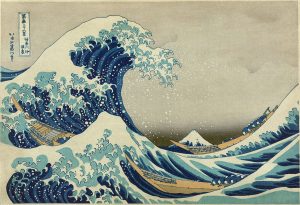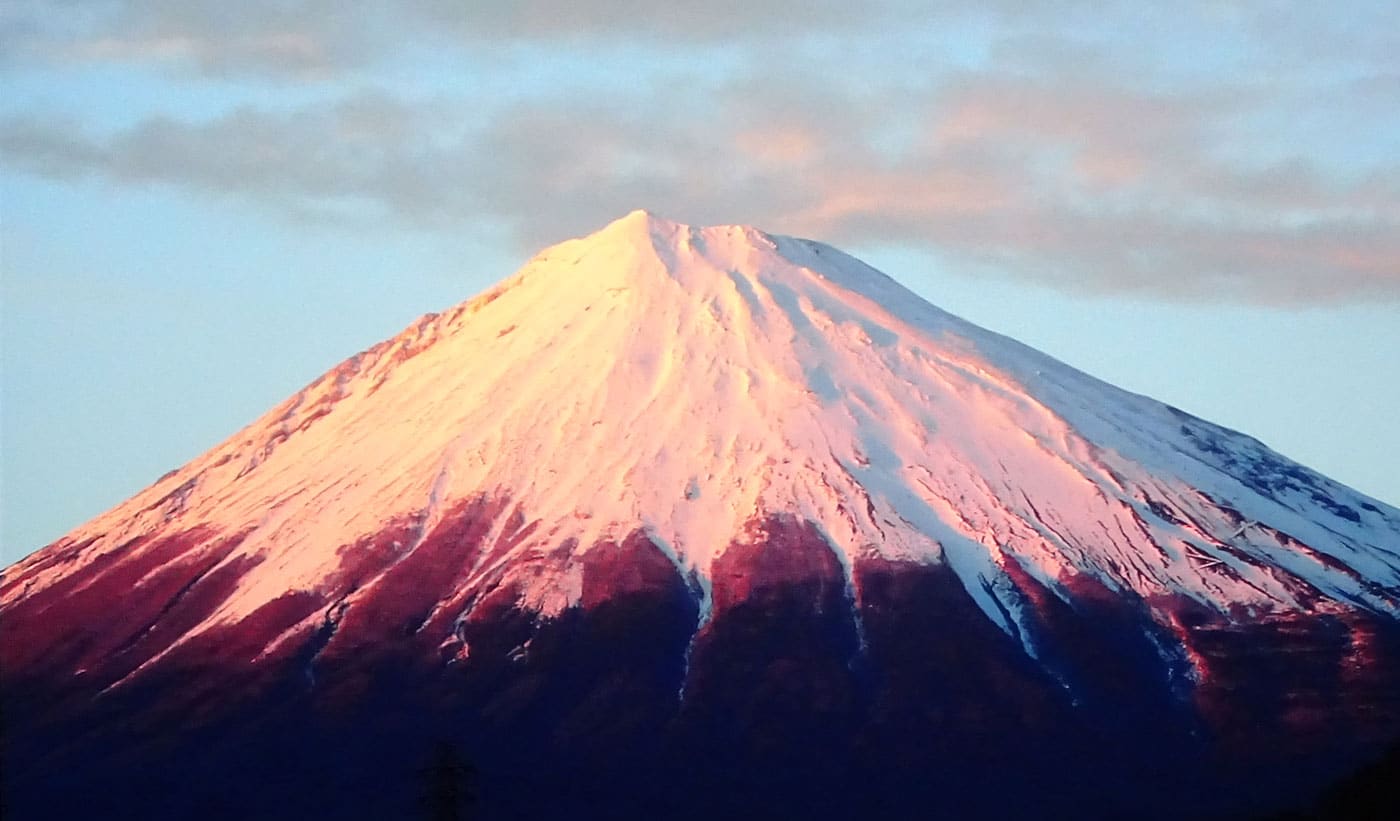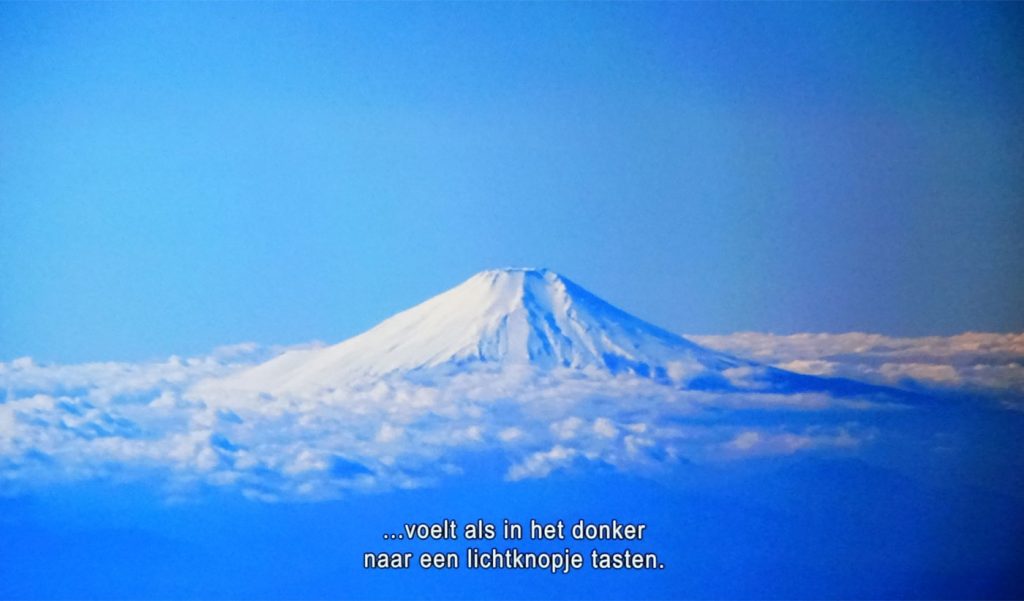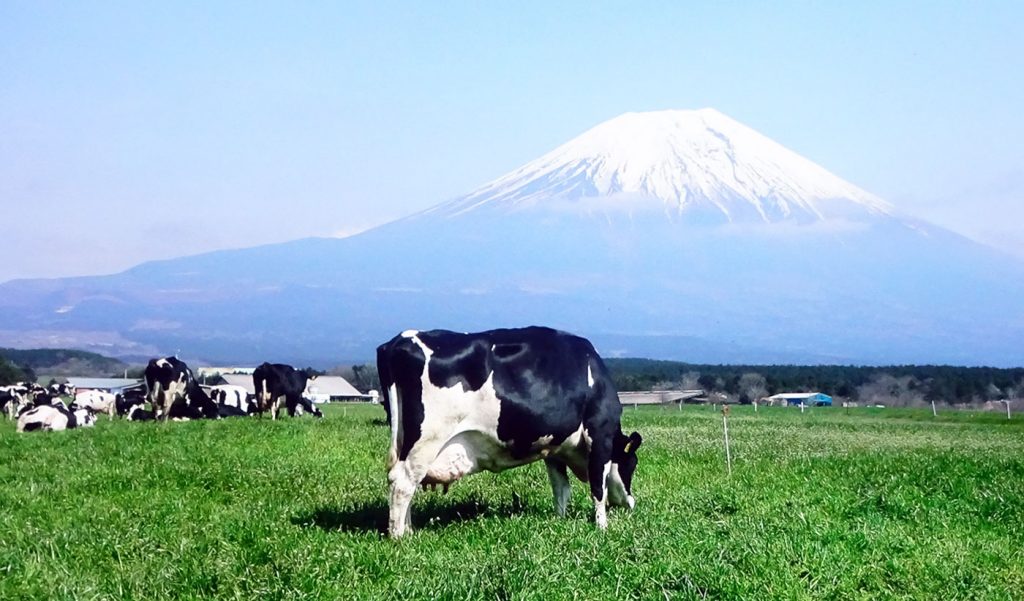Het videokunstwerk ‘Ascent’ is een van de meest recente werken van Fiona Tan. Ascent is een videokunstwerk van speelfilmlengte: 1 uur en 17 minuten[ref]Een werk dat is voortgekomen uit een speciale opdracht van het Izu Photo Museum in Japan.[/ref]. Mogelijk ben je al bekend met het werk van deze kunstenaar[ref]De inmiddels 50-jarige Fiona Tan is ‘geen gewoon Indisch meisje’, geboren in Pekan Baru (Indonesië), uit een gezin met een Chinese vader en een Australische moeder. Haar jeugdjaren brengt ze door in Australië. Nu woont en werk ze alweer ruim 25 jaar in Nederland. Na haar opleiding aan de Gerrit Rietveld Academie en de Rijksakademie, is Tan uitgegroeid tot een toonaangevende internationaal werkende kunstenaar. Haar hoofdmedium is: video, film en fotografie, de zogenoemde ‘lens-based-media’.[/ref] en zo niet, dan is dit een uitgelezen kans.
Het werk van Fiona Tan is bijzonder, of meer nog ‘uitzonderlijk’. Het is verstillend en verontrustend tegelijk. Haar video-installaties zijn herkenbaar door hun gelaagdheid en haar speciale vertelkunst. Ze hebben bijna een directe fysieke en psychologische werking op de beschouwer. Tan laat je binnen in een nieuw uniek domein, waarvan de werking je mogelijk tot dan toe onbekend was. Die onderdompeling kun je tijdens een bezoek aan het De Pont Museum in Tilburg ervaren.

De golf
Veruit het bekendste beeld van Japan is ‘De Grote Golf’. De prent Kanagawa oki nami-urea (1827), van de hand van Hokusai is al even iconisch als de vulkaan Fuji en geniet ook nu nog altijd, een ongekende populariteit. Op een of andere manier kent iedereen dit beeld van de ‘Grote Golf’ en velen zal het daarbij ontgaan, dat deze prent eigenlijk de berg Fuji als hoofdthema heeft. Nog interessanter is de Nederlandse herkomst van de kleur in het schilderij.
Nu, 150 jaar nadat Hokusai’s visie op Fuji bekend werd in Parijs, is Fiona Tan, benaderd door het Izu Photo Museum. Ze vroegen haar om een nieuw werk tot stand te brengen met deze bijzondere berg, de Fuji, als uitgangspunt. Het Izu Photo Museum zelf ligt aan de voet van de berg Fuji en bezit een uitgebreide verzameling met afbeeldingen van de berg. Daarmee was het uitgangspunt voor dit nieuwe werk, getiteld ‘Ascent’, waarschijnlijk direct duidelijk.
Stilstaande beelden doen bewegen
‘Ascent’ is uitgegroeid tot een film van 77 minuten, een visueel essay volledig opgebouwd uit een montage van circa 600 foto’s, ‘stilstaande beelden’. Ze zijn zorgvuldig geselecteerd uit de verzameling dan 4.000 beelden, die bijeengebracht zijn in het Izu Photo Museum. De verzameling reikt over alle tijdsperioden heen en volgt de verbeeldingscultuur over honderden jaren.
Uit deze stroom ‘gevonden’ stilstaande beelden van de berg Fuji heeft Tan haar videowerk gecomponeerd door middel van ordening en montage. In het uitgekiende scenario herkennen we direct haar hand. Het bewegende verstilt en het verstilde komt in beweging.
Die beweging grijpt je aan. De stroom stimuleert tot een verkenning van je geheugen. Je wordt je bewust van het vlieden van de tijd, de loop van de geschiedenis. Gelijk met het aangeboden beeld ontspint zich een verhaallijn met tal van inzichten en hier en daar een spitsvondigheid. Ons levensritme wordt vertraagd. We worden als beschouwer achterover gelegd in een origineel en gelaagd verhaal, dat als lauwwarme olie over ons heen stroomt, ons vervolgens omsluit en onderdompelt.
Icoon
Tal van menselijke eigenschappen worden aan de berg toedicht wat hem zo tot een icoon maakt. Het videowerk is een studie van de beeldcultuur en een eerbetoon aan zowel de verbeeldings- en fotogeschiedenis, zoals die is ontstaan in Japan. Hoe de culturen van Oost en West zowel met elkaar botsen als zich verbinden en vermengen.
Het werk beschouwt de verwevenheid van het direct zichtbare en het onzichtbare – de vervlogen geschiedenissen – de afstand en nabijheid die speelt rond deze berg. Zoals Tan zelf zegt: ‘Deze duizenden beelden omringen de berg als een wolk – ze openbaren en verbergen Fuji op hetzelfde moment.’
Licht en leegte
Op een bepaald moment wordt in de voice-over toegelicht dat volgens de traditie de bijzonder aanlokkende schoonheid van de Fuji beter is te waarderen vanaf grote afstand, dan van dichtbij. Hij verwijst naar gevoelens van onvervuldheid en heimwee. Immers, na alle inspanning van de beklimming, boven aan de top aangekomen, beseft de klimmer dat er niks is, niks verder, dan leegte. Hoewel leegte in het Boeddhistische Japan geen negatieve duiding heeft, wijst het eveneens op lotsbestemming en verlangen naar vervulling.
De beklimming, het maken van de zware tocht, vormt de uitdaging, de menselijke drang naar het bedwingen van de natuur. Alles vormt zich weer en vernieuwt in het licht van de zonsopkomst -ook op de top- wanneer een nieuwe dag aanbreekt.
Licht is daarmee eveneens een basiselement in het werk. Met een doordacht script wordt de beschouwer meegenomen in de omcirkeling van deze fascinerende berg. Gedoseerd komen fabel, fictie en non-fictie voorbij, gefilterd en gezeefd, tevoorschijn gebracht in de opeenstapeling van beelden. Weer in beweging gebracht, komt alles (opnieuw) tot leven. Hierin figureert Fuji onbewogen, onaantastbaar als een vaste waarde door de tijd heen.
Het is de verdienste van vertelkunst in de ‘voice-over’. Die bestaat uit twee op elkaar inhakende, maar parallel lopende monologen. Dat geeft een grotere betrokkenheid geven bij de zich ontrollende beelden.
Mary en Hiroshi
De twee commentaarstemmen vertellen een fictief verhaal. Er twee verhaallijnen, die elkaar afwisselend doorsnijden. De vertelstem van het personage Mary, een jonge vrouw, Engelse schrijfster en vertaalster, in helder Engels, thuis in haar werkkamer, handelend en mijmerend in het nu. De stem van een jonge man in het Japans. Hij is de Japanse fotograaf Hiroshi, die tijdens de tocht zelf vertelt over zijn inspanningen tijdens zijn beklimming van de Fuji.
De tekst is deels opgewekt uit de aantekeningen in zijn notitieboekjes, deels als een ‘live verslag’ maar dan van ten minste vijf jaar eerder. Mary vertelt immers dat Hiroshi vijf jaar geleden plots is overleden. Nu, even onverwachts, krijgt zij een pakket toegestuurd. Een doos met de overlevering van zijn foto’s en notities, waarbij het niet anders kan zijn dan dat ze overvallen wordt door herinneringen.
Vertelkunst
Fiona Tan toont ons hoe zij meesterlijk deze visuele vertelkunst meer en meer als geen ander beheerst en al doende ze de vraag beantwoord of je van stilstaande beelden, foto’s, weer een film kunt maken. De ‘dode’ verstilde foto’s worden tot leven wekt en opnieuw filmisch in beweging zet, voorzien van een passende ‘soundtrack’. Ze bereikt dit door de ritmische vertraging of versnelling van de ‘losse’ beelden, die zij in een nieuwe door haar bepaalde volgorde, hier aaneengeschakeld, aan ons toont met de toevoeging van passende geluiden.
 Terwijl we zo, als toeschouwers, glurend vanuit het verhullende donker van de filmzaal, naar het oplichtend scherm kijken, krijgen we een uitbreiding voorgetoverd van de grenzen van fotografie en film. Momenten van stilte gepaard met die van de beweging.
Terwijl we zo, als toeschouwers, glurend vanuit het verhullende donker van de filmzaal, naar het oplichtend scherm kijken, krijgen we een uitbreiding voorgetoverd van de grenzen van fotografie en film. Momenten van stilte gepaard met die van de beweging.
Toevoegingen, die precies een uniek gebied aanwijzen, waar film, fotografie en verbeeldingscultuur elkaar ontmoeten en zich met elkaar verbinden. In navolging van de klim naar de piek van de berg (ascent) een verhaal, dat evenzeer zigzagt over geschiedenis en belevenissen van Mary en Hiroshi. De culturele achtergronden die zij vertegenwoordigen en waardoor we via hun stemmen, hun verhalen, herinneringen en bespiegelingen, in ‘Ascent’ zó worden meegenomen, dat wij het ‘hier en nu’ ontstijgen (ascent).
Van de ukiyo-e prenten uit het Edo-tijdperk naar de Tweede Wereldoorlog, van het westerse imperialisme naar hedendaagse toerisme. Van de periode uit het begin van de fotografie tot een heden, waarin alles in beelden wordt gevat. Van geënsceneerd naar ad-hoc. Van een verrassend beeld van de Friese zwart-wit stamboek koe voor de berg Fuji, tot dubbel clichés van zalmroze tulpen of het zo gevierde icoon dat in alles verwijst naar Vincent Van Gogh. De Zonnebloem in een zee van geel voor de berg Fuji. Waarmee we weer terug zijn bij de houtsnedes, de ukiyo-e prenten van Hokusai in het Pruisisch Blauw. Een reis van 1 uur en 17 minuten: 1 berg in 150 jaar en enkele min of meer toevallige contrasten en verbanden tussen Nederland en Japan… of breder, de invloed van het Oosten en het Westen op elkaar.
Actualiteit
Naast een onderdompeling is het ook een bevraging. Even actueel als urgent. Want hoe gaan we om met feit en fictie? Wat is de realiteit van fotografie: documentair, journalistiek, historisch? Een verslag, in scene gezet, gearrangeerd. Hoe subjectief is het verhaal en wie heeft de regie? Wie bepaalt de interpretatie van de voorgeschotelde beelden? Wat is naast hun visuele zeggingskracht, hun (blijvende) betekenis? Waarvoor staat de berg of de bergfilm?
Dit alles aan de hand van die éne onverzettelijke berg, een slapende vulkaan, die sinds zijn laatste uitbarsting in 1708, zijn rust heeft genomen. Met een waarschuwing in de verhaallijn ingeschreven: ‘Aan de oppervlakte lijkt alles pais en vree, maar daaronder voel ik hoe de spanning stijgt en de scheuren zich openen. Minstens één deskundige voorspelt een uitbarsting op korte termijn…’
Ondertiteling
Een punt van aandacht is hoe soms de ondertiteling is ingebracht en hoe hinderlijk dit soms is, in een bijna perfect geheel van beeld en geluid. Als de tweetalige en tweestemmige voiceover van de personages elkaar snel opvolgen, ontstaat er een opstapeling in de ondertiteling van de stemmen van Hiroshi en Mary. Noodzakelijkerwijs, wordt daarbij het Japans zowel in Engelse- als Nederlandse tekstregels weergegeven. Al het filmisch vernuft van ‘Ascent’ dreigt dan plots even te verdrinken aan de onderrand van het beeld. In mijn ogen doet dit een weinig afbreuk aan het beleven van het werk.
Gelukkig is het niet overvol in de zaal, maar hoe hinderlijk is het als je geen vrij uitzicht hebt op het beeldscherm of erger op de voorbij vliedende tekstregels, onder in het beeld? Je een gemaakt verbanden mist, omdat je geen Japans beheerst?
Zoiets roept dan de vraag op hoe een audiovisueel werk – een film van 77 minuten – wat betreft discipline, moet worden ingedeeld. Het werk onder welke condities en met welke voorzieningen, kan worden getoond? Dit conflict zal zich niet alleen voordoen in Museum De Pont waar net vorig jaar de nieuwe uitbreiding beschikbaar is gekomen. Een vleugel, juist voor het tonen van audiovisueel beeldmateriaal in speciale video-zalen, in ‘blackbox setting’ waarbij het daglicht in tegenstelling tot in de rest van het museum, wordt geweerd.
Hechtende blik
Tan’s kunstwerken gaan in op de vraag hoe wij kijken – zowel de manier waarop onze blik zich hecht aan foto’s als de manier waarop we via die foto’s kijken naar de wereld die ons omringt. Ze gaan ook in op de werking, waarmee deze beelden – zoals spiegels – herinneringen doen ontbranden en waarbij het soms zo lijkt dat ze terugkijken naar ons. Ze laat ons opnieuw bevragen, herinneren, herbeleven. Ze doet ons opnieuw een standpunt innemen zodat we ons perspectief opnieuw moeten bepalen.
 Hoe dit alles werkt moet je het best zelf ervaren. Hoe suggestief beeld en geluid op elkaar inwerken, hoe snel je een verhaallijn voor waar aanneemt en volgt… Hoe verleidelijk dit proces en hoe tijdelijk en tijdloos beelden zijn. Zelfs als je denkt dat ze een onuitwisbare indruk op je maken… Ze vervliegen als de tijd zelf. Verstillend en verontrustend:”… ongemakkelijk als in het donker, naar het lichtknopje tastend…”.
Hoe dit alles werkt moet je het best zelf ervaren. Hoe suggestief beeld en geluid op elkaar inwerken, hoe snel je een verhaallijn voor waar aanneemt en volgt… Hoe verleidelijk dit proces en hoe tijdelijk en tijdloos beelden zijn. Zelfs als je denkt dat ze een onuitwisbare indruk op je maken… Ze vervliegen als de tijd zelf. Verstillend en verontrustend:”… ongemakkelijk als in het donker, naar het lichtknopje tastend…”.
Te zien tot 11 juni 2017 in het De Pont Museum, Tilburg.
Naar het De Pont Museum
Het als ‘museum voor de kunst van heden’ opgezette museum is zeker een bezoek waard. Dit jaar jubileert het museum en het heeft in de afgelopen 25 jaar onder leiding van de directeur Hendrik Driessen een toonaangevende collectie hedendaagse kunst opgebouwd. Het museum beschikt over een prachtige accommodatie; de tot museum omgebouwde wolspinnerij met zijn industrieel sheddak is een belevenis, waarin op zaal het daglicht overdadig over de getoonde kunstwerken wordt overgoten.
www.depont.nl
Fiona Tan (Pekan Baru, Indonesië 1966) volgde haar opleiding aan de Gerrit Rietveld Academie en de Rijksacademie in Amsterdam. Geboren in Indonesië en opgegroeid in Australië. Woont en werkt al meer dan 25 jaar in Nederland. Fiona Tan werkt voornamelijk met lens-based media, (dwz alles met een lens). Ze is vooral bekend voor haar vakkundig gemaakte video en film-installaties, in de verkenningen van het geheugen, de tijd, de geschiedenis en waarin de rol van het visuele centraal staat.
In 2009 werd ze geselecteerd om Nederland te vertegenwoordigen op de 53e Biënnale van Venetië met ‘Disoriënt’. Fiona Tan is een zeer productief kunstenaar en haar werk wordt internationaal breed getoond. Zo was een recente overzichtstentoonstelling van haar actuele werk eind 2016 te zien in het MMK in Frankfurt en natuurlijk in dezelfde periode, de presentatie van ‘Ascent’ in het Izu Photo Museum aan de voet van de Fuji, in de Prefecture Shizuoka, Japan.
www.fionatan.nl



